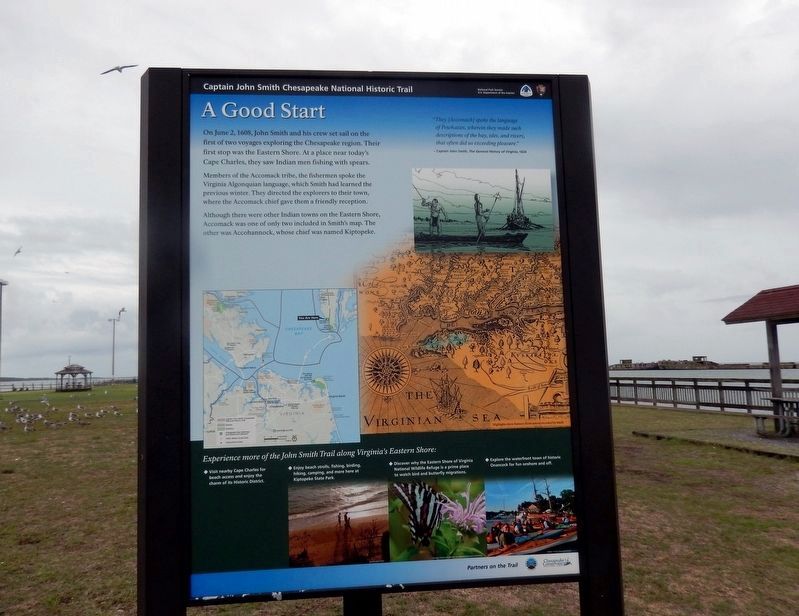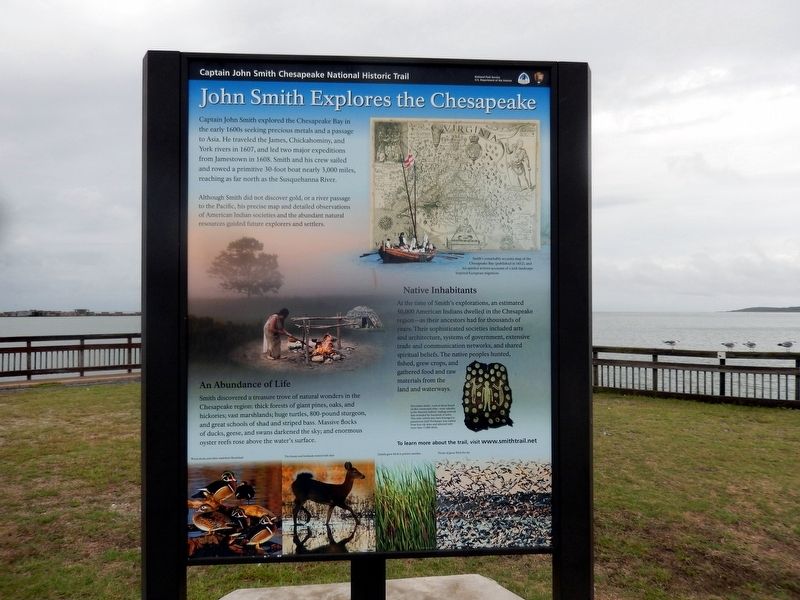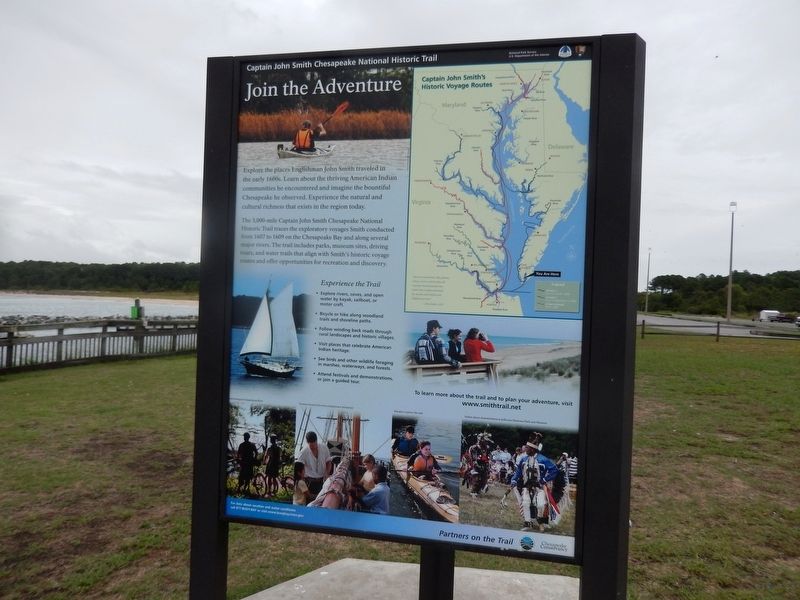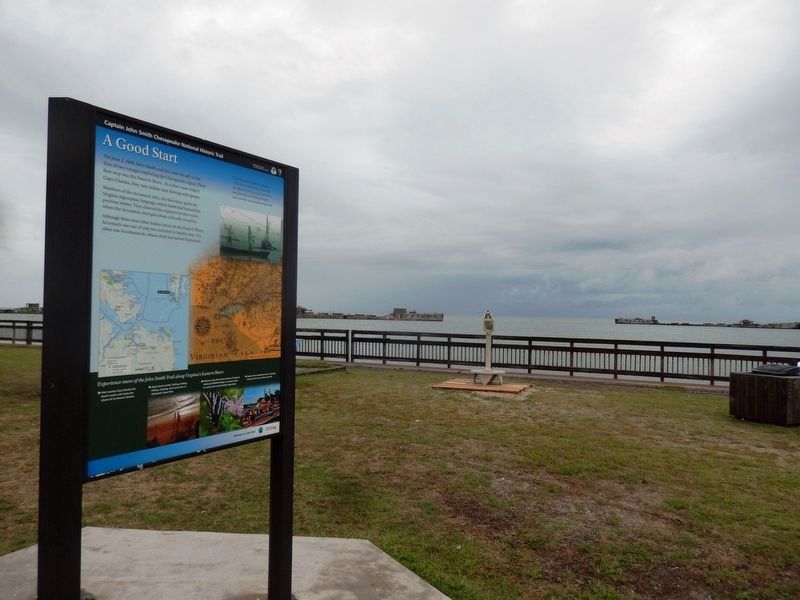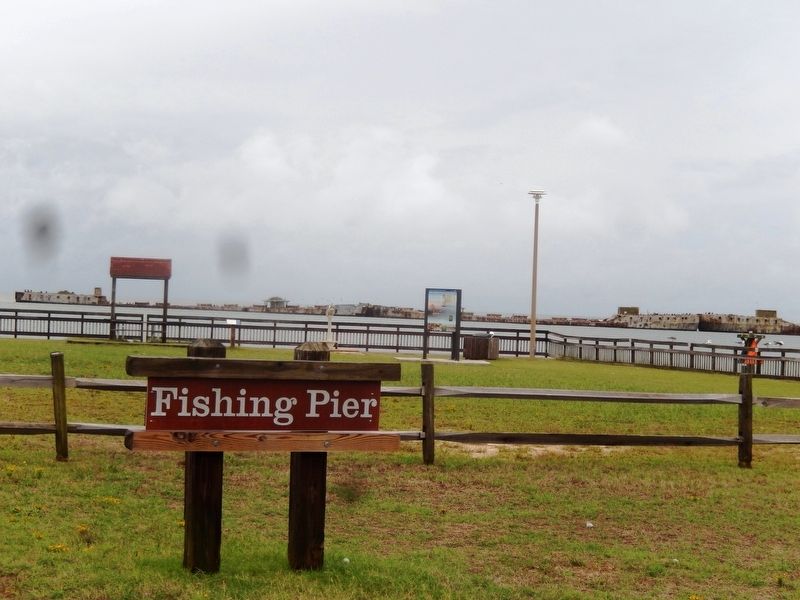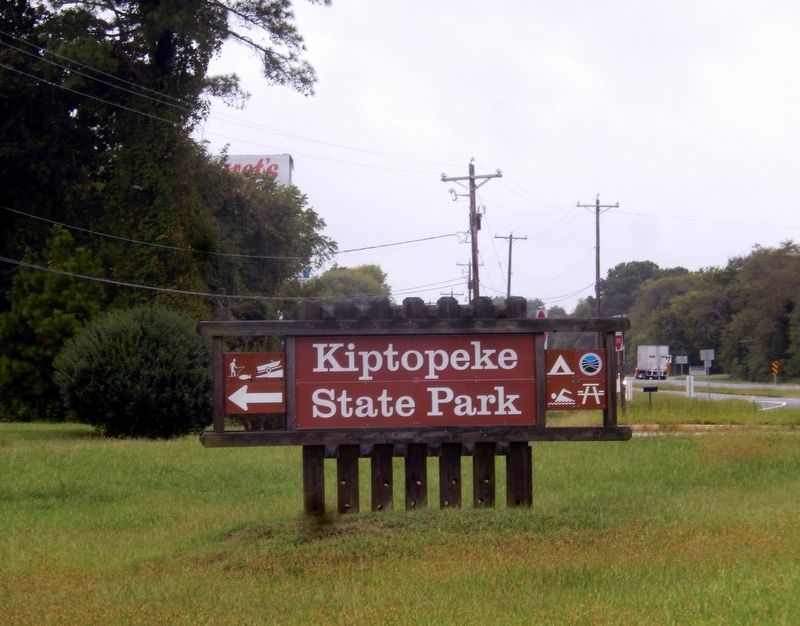Cape Charles in Northampton County, Virginia — The American South (Mid-Atlantic)
A Good Start
Captain John Smith Chesapeake National Historic Trail
— National Park Service, U.S. Department of the Interior —
(panel 1)
On June 2, 1608, John Smith and his crew set sail on the first of two voyages exploring the Chesapeake region. Their first stop was the Eastern Shore. At a place near today’s Cape Charles, they saw Indian men fishing with spears.
Members of the Accomack tribe, the fishermen spoke the Virginia Algonquian language, which Smith had learned the previous winter. They directed the explorers to their own town, where the Accomack chief gave them a friendly reception.
Although there were other Indian towns on the Eastern Shore, Accomack was one of only two included in Smith’s map. The other was Accohannock, whose chief was named Kiptopeke.
“They (Accomack) spoke the language of Powhatan, wherein they made such descriptions of the bays, isles, and rivers, that often did us exceeding pleasure.”
–Captain John Smith, The General History of Virginia, 1624
(sidebar)
Experience more of the John Smith Trail along Virginia’s Eastern Shore:
• Visit nearby Cape Charles for beach access and enjoy the charm of its Historic District.
• Enjoy beach strolls, fishing, birding, hiking, camping, and more here at Kiptopeke State Park.
• Discover why the Eastern Shore of Virginia National Wildlife Refuge is a prime place to watch bird and butterfly migrations.
• Explore the waterfront town of historic Onancock for fun onshore and off.
(panel 2)
Join the Adventure
Explore the places Englishman John Smith traveled in the early 1600s. Learn about the thriving American Indian communities he encountered and imagine the bountiful Chesapeake he observed. Experience the natural and cultural richness that exists in the region today.
The 3,000-mile Captain John Smith Chesapeake National Historic Trail traces the exploratory voyages Smith conducted from 1607 to 1609 on the Chesapeake Bay and along several major rivers. The trail includes parks, museum sites, driving tours, and water trails that align with Smith’s historic voyage routes and offer opportunities for recreation and discovery.
Experience the Trail
• Explore rivers, coves, and open water by kayak, sailboat, or motor craft.
• Bicycle or hike along woodland trails and shoreline paths.
• Follow winding back roads through rural landscapes and historic villages.
• Visit places that celebrate American Indian heritage.
• See birds and other wildlife foraging in marshes, waterways, and forests.
• Attend festivals and demonstrations, or join a guided tour.
To learn more about the trail and to plan your adventure, visit www.smithtrail.net
(captions)
(upper
right) Captain John Smith’s Historic Voyage Routes. “Here are mountains, hills, plains, valleys, rivers, and brooks all running most pleasantly into a faire Bay compassed but for the mouth with fruitful and delightsome land.” —John Smith, 1612
(bottom) Overlooking the Susquehanna River; Students aboard Discovery at Jamestown Settlement; Kayakers explore the trail; Indian dance demonstration at Jefferson Patterson Park and Museum.
Erected by National Park Service, U.S. Department of the Interior.
Topics and series. This historical marker is listed in these topic lists: Colonial Era • Exploration • Native Americans • Settlements & Settlers. In addition, it is included in the Captain John Smith Chesapeake National Historic Trail series list. A significant historical date for this entry is June 2, 1608.
Location. 37° 9.998′ N, 75° 59.333′ W. Marker is in Cape Charles, Virginia, in Northampton County. Marker is on Kiptopeke Drive (County Route 704) 1.4 miles west of Lankdorf Highway (U.S. 13). The marker is located on the fishing pier at Keptopeke State Park. Touch for map. Marker is at or near this postal address: 3540 Kiptopeke Drive, Cape Charles VA 23310, United States of America. Touch for directions.
Other nearby markers. At least 8 other markers are within 5 miles of this marker, measured as the crow flies. Concrete Ships (here, next to this marker); The Dunes (about 700 feet away, measured in a direct line); Chesapeake Bay (about 700 feet away); Farm to Market (about 700 feet away); Maritime Highway (about 700 feet away); Chesapeake Bay Bridge-Tunnel (approx. 2.7 miles away); Fisherman Island NWR (approx. 3.3 miles away); Mansion Site (approx. 4.4 miles away). Touch for a list and map of all markers in Cape Charles.
Credits. This page was last revised on June 12, 2020. It was originally submitted on October 8, 2016, by Don Morfe of Baltimore, Maryland. This page has been viewed 441 times since then and 36 times this year. Photos: 1, 2, 3, 4, 5, 6. submitted on October 8, 2016, by Don Morfe of Baltimore, Maryland. • Bernard Fisher was the editor who published this page.
